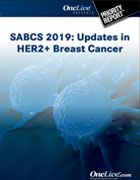Publication
Article
Priority Report
Adjuvant T-DM1 Benefit in HER2+ Breast Cancer Observed Across Key Subgroups
Author(s):
The invasive disease-free survival benefit with adjuvant T-DM1 versus trastuzumab in patients with HER2-positive early breast cancer who had residual invasive disease following neoadjuvant therapy was observed regardless of the type of neoadjuvant chemotherapy used.
Max S. Mano, MD, PhD, Instituto do Cancer do Estado de San Paulo

Max S. Mano, MD, PhD
The KATHERINE trial included 1486 patients with HER2-positive, nonmetastatic invasive primary breast cancer who were randomized in a 1:1 ratio to adjuvant T-DM1 or trastuzumab. Prior neoadjuvant therapy had to consist of ≥6 cycles of chemotherapy containing a taxane (with or without anthracycline) and ≥9 weeks of trastuzumab.
At the 2019 San Antonio Breast Cancer Symposium (SABCS), lead study author Max S. Mano, MD, PhD, presented a poster with several subanalyses of the trial, including a comparison of patients who received anthracycline (AC)-based NACT versus those who received non-AC­—based NACT.
The HR for iDFS was 0.51 (95% CI, 0.38-0.67) and 0.43 (95% CI, 0.22-0.82) favoring T-DM1 for the AC and non-AC groups, respectively. In the AC arm, the 3-year iDFS rates were 87.4% with T-DM1 versus 75.7% with trastuzumab. In the non-AC arm, the 3-year iDFS rates were 91.7% versus 81.4%, respectively.
These data compare favorably with the overall population results of the KATHERINE trial, in which T-DM1 reduced the risk of invasive disease recurrence or death by 50% (HR, 0.50; 95% CI, 0.39-0.64; P <.001), and the 3-year iDFS rates were 88.3% with T-DM1 versus 77.0% with trastuzumab.
For their analysis, the researchers also identified 4 mutually exclusive high-risk subgroups. Although these were small subsets, there was an improvement in the 3-year iDFS rate with T-DM1 across all 4 subgroups.
Among 375 patients who were inoperable at presentation irrespective of hormone receptor and ypN status, the 3-year iDFS rates were 76% and 60.2% with T-DM1 and trastuzumab, respectively (HR, 0.54; 95% CI, 0.37-0.80). The corresponding rates were 76% and 69.5% (HR, 0.72; 95% CI, 0.35-1.50), respectively, among 110 patients who were operable at presentation with ypN-positive nodes and hormone receptor—negative disease.
In 335 patients who were operable at presentation with ypN-positive nodes and hormone receptor—positive disease, the 3-year iDFS rates were 91.4% and 77.2% with T-DM1 and trastuzumab, respectively (HR, 0.43; 95% CI, 0.25-0.75). The corresponding rates were 91.1% and 77.2% (HR, 0.43; 95% CI, 0.17-1.06), respectively, among 137 patients who were operable at presentation with ypN-negative nodes and hormone receptor–negative disease.
“All of the high-risk patient subgroups benefited from T-DM1,” Mano, who is from the Instituto do Câncer do Estado de São Paulo, São Paulo, Brazil, said in an interview with OncLive at SABCS.
Outcomes were also assessed in 77 lower-risk patients with small tumors (cT1 cN0) at presentation—45 patients in the T-DM1 arm and 32 in the trastuzumab arm. Overall, patient characteristics were well balanced between the 2 arms. Results showed that there were 6 iDFS events in the trastuzumab group and none in the T-DM1 group.
“The benefit from T-DM1 was the same in these patients as in the full trial population.” These patients with small tumors are usually referred to surgery, but Mano said these data may cause him to rethink this. “Perhaps we should be more careful in this patient population. Maybe some of these patients are better treated with neoadjuvant chemotherapy.”
Demographic/Safety Data for NACT Cohorts
In their poster, the Mano et al also drilled down on patient demographic and safety data across the NACT cohorts.
Overall, 77% of patients received AC-based NACT. In the AC arm, 579 patients received T-DM1 and 564 patients received trastuzumab. In the non-AC arm, 164 patients received T-DM1 and 179 patients received trastuzumab.
Patient characteristics were, for the most part, well balanced across the treatments arms, regardless of the type of neoadjuvant regimen. The median patient age was around 50 years old, about two-thirds of patients were white, approximately three-fourths of patients were ER- and/or PgR-positive, and about 80% of patients received adjuvant radiotherapy.
A higher percent of patients in the AC arm had an ECOG performance status of 0, at about 84% versus about 72% in the non-AC arm. The authors also noted in their poster that “patients treated with AC-based NACT were less likely to be from North America and less likely to be Asian.”
Regarding neoadjuvant HER2-targeted therapy, about 90% of patients in the AC arm had received trastuzumab alone and about 10% had received trastuzumab plus pertuzumab (Perjeta). The corresponding rates in the non-AC arm were about 55% and 45%, respectively.
Also across the non-AC arm, about three-fourths of patients received neoadjuvant carboplatin/cisplatin and about 95% were treated with a neoadjuvant taxane for >12 weeks.
Overall, the safety profile was similar between the AC and non-AC arms. Adverse events (AEs) reported in previous studies to have occurred more commonly with T-DM1 or trastuzumab (eg, hepatotoxicity, peripheral neuropathy, hemorrhage, infusion-related reaction/hypersensitivity, and cardiac dysfunction) had similar all-grade incidence rates between the AC- and non-AC cohorts.
The researchers did note, however, that all-grade thrombocytopenia occurred at a higher rate (32.5% vs 27.4%) in the T-DM1 non-AC arm compared with the T-DM1
AC group. The non-AC T-DM1 arm also had higher all-grade pulmonary toxicity at 6.7% versus 1.7% in the AC T-DM1 arm.
Grade ≥3 AEs occurred at higher rates in the non-AC T-DM1 group versus the AC T-DM1 group at 39.9% versus 21.7%, respectively. The largest differences in grade ≥3 AEs between the 2 arms occurred with thrombocytopenia (10.4% vs 4.3%, respectively) and peripheral sensory neuropathy (4.3% vs 0.5%, respectively).
Addressing these disparities, Mano et al wrote, “Factors that may have contributed to the increased toxicity [in the non-AC T-DM1 group] include differences in baseline characteristics (eg, a higher proportion of patients with ECOG performance status 1 and a higher proportion of Asian patients) and prior therapy (eg, a higher proportion of patients receiving platinum-based therapy and >12 weeks of taxane therapy in the non-AC group).”
Mano noted that the increased AEs in the non-AC T-DM1 group were usually resolved and “did not impact treatment continuation.”
AE-related discontinuation rates of T-DM1 (19.6% vs 17.5%) and AE-related T-DM1 dose-reduction rates (14.1% vs 11.6%) were similar, regardless of the type of NACT regimen.
Based on the overall population analysis of KATHERINE, the FDA approved T-DM1 in May 2019 for use as an adjuvant treatment of patients with HER2-positive early breast cancer who have residual invasive disease following neoadjuvant trastuzumab and chemotherapy.
Mano MS, Loibl S, Mamounas, EP et al. Adjuvant trastuzumab emtansine (T-DM1) vs trastuzumab (H) in patients with residual invasive disease after neoadjuvant therapy for HER2-positive breast cancer: KATHERINE subgroup analysis. Presented at: 2019 San Antonio Breast Cancer Symposium; December 10-14; San Antonio, TX. Abstract P3-14-01.
<<< View more from 2019 San Antonio Breast Cancer Symposium
The invasive disease-free survival (iDFS) benefit with adjuvant ado-trastuzumab emtansine (T-DM1; Kadcyla) versus trastuzumab (Herceptin) in patients with HER2-positive early breast cancer who had residual invasive disease following neoadjuvant therapy was observed regardless of the type of neoadjuvant chemotherapy (NACT) used. A benefit with T-DM1 was also observed across several high-risk patient populations, according to subgroup analyses from the phase III KATHERINE trial.










